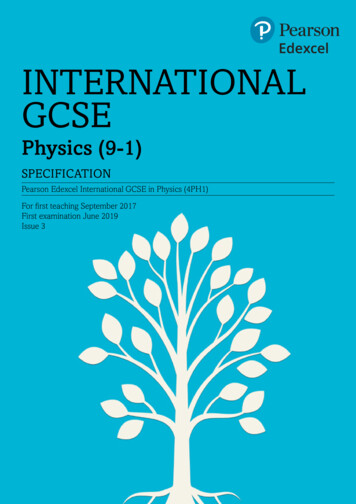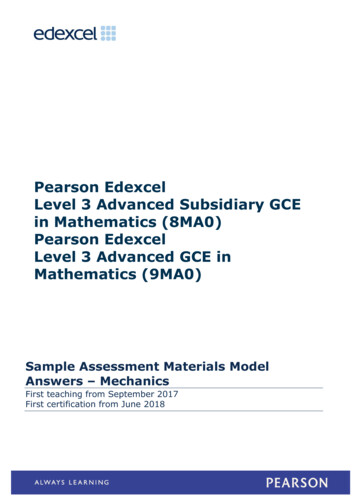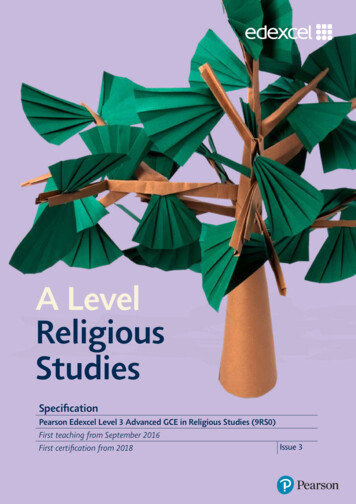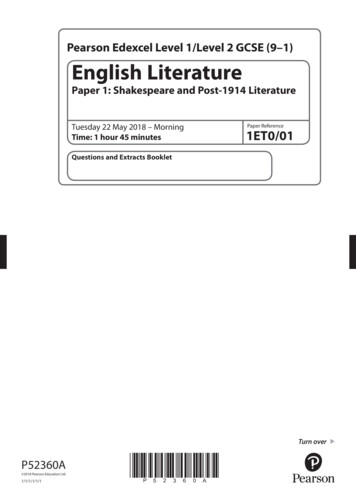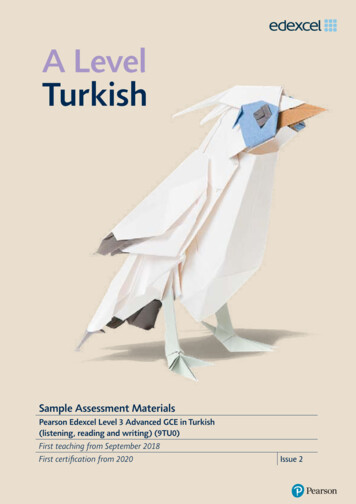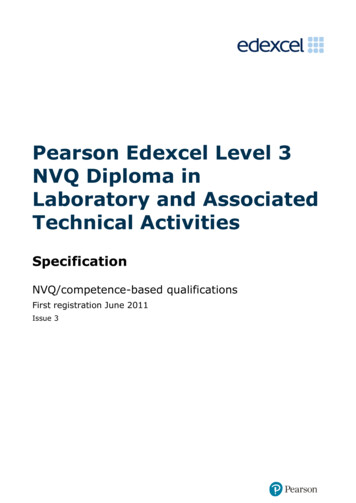
Transcription
Pearson Edexcel Level 3NVQ Diploma inLaboratory and AssociatedTechnical ActivitiesSpecificationNVQ/competence-based qualificationsFirst registration June 2011Issue 3
Edexcel, BTEC and LCCI qualificationsEdexcel, BTEC and LCCI qualifications are awarded by Pearson, the UK’s largest awardingbody offering academic and vocational qualifications that are globally recognised andbenchmarked. For further information, please visit our qualifications website atqualifications.pearson.com. Alternatively, you can get in touch with us using the details onour contact us page at qualifications.pearson.com/contactusAbout PearsonPearson is the world's leading learning company, with 35,000 employees in more than 70countries working to help people of all ages to make measurable progress in their livesthrough learning. We put the learner at the centre of everything we do, because whereverlearning flourishes, so do people. Find out more about how we can help you and yourlearners at qualifications.pearson.comThis specification is Issue 3. Key changes are listed in the summary table on the next page.We will inform centres of any changes to this issue. The latest issue can be found on thePearson website: qualifications.pearson.comThis qualification was previously known as:Pearson Edexcel Level 3 NVQ Diploma in Laboratory and Associated Technical Activities(QCF)The QN remains the same.References to third party material made in this specification are made in good faith. Pearsondoes not endorse, approve or accept responsibility for the content of materials, which maybe subject to change, or any opinions expressed therein. (Material may include textbooks,journals, magazines and other publications and websites.)All information in this specification is correct at time of going to publication.ISBN 9781446953341All the material in this publication is copyright Pearson Education Limited 2017
Summary of Pearson Edexcel Level 3 NVQ Diploma inLaboratory and Associated Technical Activities specificationIssue 3 changesSummary of changes made between previous issue and thiscurrent issuePage/sectionnumberAll references to QCF have been removed throughout the specificationDefinition of TQT addedDefinition of sizes of qualifications aligned to TQTTQT value addedGuided learning definition updatedQCF references removed from unit titles and unit levels in all unitsPagePagePagePagePage1261213-207Earlier issue(s) show(s) previous changes.If you need further information on these changes or what they mean, contact us via our websiteat: tml.
ContentsIntroducing Pearson Edexcel NVQ/Competence-based qualifications1Qualification title covered by this specification3Key features of the Level 3 NVQ Diploma in Laboratory and AssociatedTechnical Activities4What is the purpose of this qualification?4Who is this qualification for?4What are the potential job roles for those working towards this qualification? 4What progression opportunities are available to learners who achieve thisqualification?5What is the qualification structure for the Pearson Edexcel Level 3Diploma in Laboratory and Associated Technical Activities?6How is the qualification graded and assessed?9Assessment requirements/strategy9Types of evidence (to be read in conjunction with the assessment strategy inAnnexe C)10Centre recognition and approval11Centre recognition11Approvals agreement11Quality assurance11What resources are required?11Unit format12Units 13Unit 1:Maintain health and safety in a scientific or technical workplace15Unit 2: Maintain effective and efficient working relationships for scientific ortechnical activities24Unit 3:Carry out scientific or technical testing operationsUnit 4: Access and communicate scientific or technical information toauthorised personnel3139Unit 5: Provide technical advice and guidance for scientific or technicalactivities 47Unit 6:Plan scientific or technical sampling and testing activities56Unit 7:Carry out complex scientific or technical testing operations65Unit 8:Carrying out complex scientific or technical sampling operations74
Unit 9:Carry out scientific or technical investigations82Unit 10: Carry out small scale processing90Unit 11 Diagnose faults, repair and maintain scientific or technical equipmentfor workplace activities97Unit 12: Measuring, weighing and preparing compounds and solutions forlaboratory use106Unit 13: Maintain and control stocks of all resources, equipment andconsumables for scientific or technical activities115Unit 14: Make presentations for scientific or technical activities in theworkplace124Unit 15: Assess their own scientific or technical knowledge and skills forworkplace activities132Unit 16Provide training for scientific or technical activities in the workplace139Unit 17: Provide scientific or technical leadership for a workplace team147Unit 18: Following aseptic procedures in the laboratory environment156Unit 19: Evaluate and provide scientific or technical assistance for learningactivities 166Unit 20 Demonstrate scientific or technical methods, techniques and skills toothers in the workplace174Unit 21 Improve the quality and reliability of scientific or technical activitiesin the workplace182Unit 22: Test and evaluate new scientific or technical methods and equipmentfor learning activities190Unit 23: Provide technical support for computer application software andequipment for learning activities200Further information208Useful publications209How to obtain National Occupational Standards209Professional development and training210Annexe A: Quality assurance211Key principles of quality assurance211Quality assurance processes211Annexe B: Centre certification and registrationWhat are the access arrangements and special considerations for thequalifications in this specification?Annexe C: Assessment sor Requirements to Demonstrate Effective Assessment Practice215
Assessor Technical Requirements215Verifier Requirements (internal and external)216Specific technical requirements for internal and external verifiers217Technical Requirements for Assessors and Verifiers217Notes217Assessment Environment218Access to Assessment219Carrying Out Assessment219Minimum Performance Evidence Requirements219Assessing knowledge and understanding220Witness testimony221Quality Control of Assessment221Annexe D: Additional requirement for qualifications that use the term‘NVQ’ in a qualification title223
Introducing Pearson Edexcel NVQ/Competence-basedqualificationsWhat are NVQ/Competence-based qualifications?National Vocational Qualifications (NVQs)/Competence-based qualifications are work-basedqualifications that give learners the opportunity to develop and demonstrate theircompetence in the area of work or job role to which the qualification relates.NVQs/Competence-based qualifications are based on recognised occupational standards forthe appropriate sector. Occupational standards define what employees, or potentialemployees, must be able to do and know, and how well they should undertake work tasksand work roles. These standards are written in broad terms to enable employers andproviders to apply them to a wide range of related occupational areas.NVQs/Competence-based qualifications are outcomes-based with no fixed learningprogramme, therefore allowing flexible delivery to meet the individual learner’s needs. AtLevel 2 and above, these qualifications are recognised as approved training anddevelopment courses for employees that have been in the workplace for some time or as away of inducting, training and developing new entrants into the workplace. Qualifications atLevel 1 can be used in Traineeships, which enables progression to entry level employment orto Apprenticeship programmes.Learners will work towards their qualification in the workplace or in settings that replicatethe working environment as specified in the assessment requirements. Colleges, trainingcentres and/or employers can offer these qualifications as long as they have access toappropriate physical and human resources and have the necessary quality assurancesystems in place.Sizes of NVQ/Competence-based qualificationsFor all regulated qualifications, Pearson specify a total number of hours that it is estimatedlearners will require to complete and show achievement for the qualification – this is theTotal Qualification Time (TQT). The TQT value indicates the size of a qualification.Within the TQT, Pearson identifies the number of Guided Learning Hours (GLH) that weestimate a centre delivering the qualification might provide. Guided learning meansactivities, such as lessons, tutorials, online instruction, supervised study and giving feedbackon performance, that directly involve tutors and assessors in teaching, supervising andinvigilating learners. Guided learning includes the time required for learners to completeexternal assessment under examination or supervised conditions.In addition to guided learning, other required learning directed by tutors or assessors willinclude private study, preparation for assessment and undertaking assessment when notunder supervision, such as preparatory reading, revision and independent research.As well as TQT and GLH, qualifications can also have a credit value – equal to one tenth ofTQT, rounded to the nearest whole number.TQT and credit values are assigned after consultation with users of the qualifications.NVQ/Competence-based qualifications are available in the following sizes: Award – a qualification with a TQT value of 120 or less (equivalent to a range of1–12 credits) Certificate – a qualification with a TQT value in the range of 121–369(equivalent to a range of 13–36 credits) Diploma – a qualification with a TQT value of 370 or more(equivalent to 37 credits and above).Specification – Level 3 Diploma in Laboratory and Associated TechnicalActivities – Issue 23 –December 2017 Pearson Education Limited 20171
Qualification title covered by this specificationThis specification gives you the information you need to offer the Pearson Edexcel Level 3 Diploma in Laboratory and Associated TechnicalActivities:Qualification titleQualificationNumber (QN)Accreditationstart datePearson Edexcel Level 3 NVQ Diploma in Laboratory and Associated TechnicalActivities600/1731/401/06/11You should use the Qualification Number (QN), when you wish to seek public funding for your learners. Each unit within a qualification willalso have a unique reference number, which is listed in this specification.The qualification title and unit reference numbers will appear on the learners’ final certification document. Learners need to be made aware ofthis when they are recruited by the centre and registered with Pearson.Specification – Level 3 Diploma in Laboratory and Associated TechnicalActivities – Issue 23 –December 2017 Pearson Education Limited 20173
Key features of the Level 3 NVQ Diploma inLaboratory and Associated Technical ActivitiesThis qualification: is nationally recognised is based on the Level 3 Laboratory and Associated Technical Activities (NOS).The NOS, assessment requirements/strategy and qualification structure(s) areowned by SEMTA.The Pearson Edexcel Level 3 NVQ in Laboratory and AssociatedTechnical Activities have been approved as components for theLevel 3 Laboratory Technicians Apprenticeship framework.What is the purpose of this qualification?The Pearson Edexcel Level 3 NVQ Diploma in Laboratory and Associated TechnicalActivities provides recognition of the skills and knowledge of individuals who workin a laboratory. It covers health and safety; effective working relationships; dealingwith laboratory specimens/samples and communicating information. It contains twoPathways: Industrial Science and Education Science.Who is this qualification for?This qualification is for all learners aged 18 and above who are capable of reachingthe required standards.Pearson’s policy is that the qualification should: be free from any barriers that restrict access and progression ensure equality of opportunity for all wishing to access the qualification(s).What are the potential job roles for those working towards this qualification? Analytical scientist Biochemist Biomedical scientist Biologist Biotechnologist Clinical scientist Microbiologist Physicist Research scientist4Specification – Level 3 Diploma in Laboratory and Associated TechnicalActivities – Issue 23 –December 2017 Pearson Education Limited 2017
Education laboratory technician Laboratory technician Medical laboratory assistant Scientific laboratory technicianWhat progression opportunities are available to learners who achieve thisqualification?Progression from this qualification can be to other relevant level 3 and/or level 4qualifications, for example: Pearson Edexcel Level 3 NVQ Diploma in Laboratory Science Pearson Edexcel Level 4 NVQ Diploma in Laboratory and Associated TechnicalActivities. Pearson Edexcel Level 4 HNC in Applied Biology Pearson Edexcel Level 4 HNC in Applied Chemistry.Specification – Level 3 Diploma in Laboratory and Associated TechnicalActivities – Issue 23 –December 2017 Pearson Education Limited 20175
What is the qualification structure for the PearsonEdexcel Level 3 Diploma in Laboratory andAssociated Technical Activities?The Total Qualification Time (TQT) for this qualification is 480 hours.The Guided Learning Hours (GLH) for this qualification is 300.Within the Pearson Edexcel Level 3 Diploma in Laboratory and Associated TechnicalActivities learners may achieve one of the following pathways: Education Science orIndustrial Science.For the Education Science pathway learners must achieve a minimum of 48 creditsby completing two common mandatory units, one pathway mandatory specific unitand five pathway specific optional units. Three of these optional units should betaken from Group A and the remaining units may be taken from Group A or GroupB, within the Education Science pathway.For the Industrial Science pathway learners must achieve a minimum of 60 creditsby completing two common mandatory units, three pathway mandatory specificunits and three pathway specific optional units. Two of these optional units shouldbe taken from Group A; the remaining unit may be taken from Group A or Group Bwithin the Industrial Science pathway.UnitTitleCreditLevelCommon Mandatory unitsUnit 1:Maintain health and safety in a scientific ortechnical workplace53Unit 2:Maintain effective and efficient workingrelationships for scientific or technical activities536Specification – Level 3 Diploma in Laboratory and Associated TechnicalActivities – Issue 23 –December 2017 Pearson Education Limited 2017
UnitTitleCreditLevelEducation Science PathwayMust complete the following unit plus five more optional units (three must come fromGroup A).Unit 19:Evaluate and provide scientific or technicalassistance for learning activities63Group A - Optional unitsUnit 11:Diagnose faults, repair and maintain scientific ortechnical equipment for workplace activities83Unit 16:Provide training for scientific or technicalactivities in the workplace83Unit 20:Demonstrate scientific or technical methods,techniques and skills to others in the workplace83Unit 21:Improve the quality and reliability of scientific ortechnical activities in the workplace103Unit 22:Test and evaluate new scientific or technicalmethods and equipment for learning activities123Unit 23:Provide technical support for computerapplication software and equipment for learningactivities103Maintain and control stocks of all resources,equipment and consumables for scientific ortechnical activities43Unit 14:Make presentations for scientific or technicalactivities in the workplace63Unit 15:Assess their own scientific or technicalknowledge and skills for workplace activities43Unit 17:Provide scientific or technical leadership for aworkplace team163Group B - Optional unitsUnit 13:Specification – Level 3 Diploma in Laboratory and Associated TechnicalActivities – Issue 23 –December 2017 Pearson Education Limited 20177
UnitTitleCreditLevelIndustrial Science PathwayMust complete the following units plus three more optional units (two must come fromGroup A).Unit 3:Carry out scientific or technical testingoperationsUnit 4:Access and communicate scientific or technicalinformation to authorised personnelUnit 5:Provide technical advice and guidance forscientific or technical activities12363123Group A - Optional unitsUnit 6:Plan scientific or technical sampling and testingactivities83Unit 7:Carry out complex scientific or technical testingoperations123Unit 8:Carrying out complex scientific or technicalsampling operations83Unit 9:Carry out scientific or technical investigations93Unit 10:Carry out small scale processing83Unit 11:Diagnose faults, repair and maintain scientific ortechnical equipment for workplace activities83Unit 12:Measuring, weighing and preparing compoundsand solutions for laboratory use163Maintain and control stocks of all resources,equipment and consumables for scientific ortechnical activities43Unit 14:Make presentations for scientific or technicalactivities in the workplace63Unit 15:Assess their own scientific or technicalknowledge and skills for workplace activities43Unit 16:Provide training for scientific or technicalactivities in the workplace83Unit 17:Provide scientific or technical leadership for aworkplace team163Unit 18:Following aseptic procedures in the laboratoryenvironment92Group B - Optional unitsUnit 13:8Specification – Level 3 Diploma in Laboratory and Associated TechnicalActivities – Issue 23 –December 2017 Pearson Education Limited 2017
How is the qualification graded and assessed?The overall grade for the qualification is a ‘pass’. The learner must achieve all therequired units within the specified qualification structure.To pass a unit the learner must: achieve all the specified learning outcomes satisfy all the assessment criteria by providing sufficient and valid evidence foreach criterion show that the evidence is their own.The qualifications are designed to be assessed: in the workplace or in conditions resembling the workplace, as specified in the assessmentrequirements/strategy for the sector, or as part of a training programme.Assessment requirements/strategyThe assessment strategy for this qualification has been included in Annex D. It hasbeen developed by SEMTA in partnership with employers, training providers,awarding organisations and the regulatory authorities. The assessment strategyincludes details on: criteria for defining realistic working environments roles and occupational competence of assessors, expert witnesses, internalverifiers and standards verifiers quality control of assessment evidence requirements.Evidence of competence may come from: current practice where evidence is generated from a current job role a programme of development where evidence comes from assessmentopportunities built into a learning/training programme whether at or away fromthe workplace the Recognition of Prior Learning (RPL) where a learner can demonstratethat they can meet the assessment criteria within a unit through knowledge,understanding or skills they already possess without undertaking a course oflearning. They must submit sufficient, reliable and valid evidence for internaland standards verification purposes. RPL is acceptable for accrediting a unit,several units or a whole qualification a combination of these.Specification – Level 3 Diploma in Laboratory and Associated TechnicalActivities – Issue 23 –December 2017 Pearson Education Limited 20179
It is important that the evidence is:Validrelevant to the standards for which competence is claimedAuthenticproduced by the learnerCurrentsufficiently recent to create confidence that the same skill,understanding or knowledge persist at the time of the claimReliableindicates that the learner can consistently perform at this levelSufficientfully meets the requirements of the standards.Types of evidence (to be read in conjunction with the assessment strategy inAnnexe C)To successfully achieve a unit the learner must gather evidence which shows thatthey have met the required standard in the assessment criteria. Evidence can takea variety of different forms including the examples below. Centres should refer tothe assessment strategy for information about which of the following arepermissible. direct observation of the learner’s performance by their assessor (O) outcomes from oral or written questioning (Q&A) products of the learner’s work (P) personal statements and/or reflective accounts (RA) outcomes from simulation, where permitted by the assessment strategy (S) professional discussion (PD) assignment, project/case studies (A) authentic statements/witness testimony (WT) expert witness testimony (EPW) evidence of Recognition of Prior Learning (RPL).The abbreviations may be used for cross-referencing purposes.Learners can use one piece of evidence to prove their knowledge, skills andunderstanding across different assessment criteria and/or across different units. Itis, therefore, not necessary for learners to have each assessment criterion assessedseparately. Learners should be encouraged to reference the assessment criteria towhich the evidence relates.Evidence must be made available to the assessor, internal verifier and Edexcelstandards verifier. A range of recording documents is available on the Pearsonwebsite: qualifications.pearson.com. Alternatively, centres may develop their own.10Specification – Level 3 Diploma in Laboratory and Associated TechnicalActivities – Issue 23 –December 2017 Pearson Education Limited 2017
Centre recognition and approvalCentre recognitionCentres that have not previously offered Pearson qualifications need to apply forand be granted centre recognition as part of the process for approval to offerindividual qualifications. New centres must complete both a centre recognitionapproval application and a qualification approval application.Existing centres will be given ‘automatic approval’ for a new qualification if they arealready approved for a qualification that is being replaced by the new qualificationand the conditions for automatic approval are met. Centres already holding Pearsonapproval are able to gain qualification approval for a different level or differentsector via Edexcel online.Approvals agreementAll centres are required to enter into an approvals agreement which is a formalcommitment by the head or principal of a centre to meet all the requirements of thespecification and any linked codes or regulations. Pearson will act to protect theintegrity of the awarding of qualifications, if centres do not comply with theagreement. This could result in the suspension of certification or withdrawal ofapproval.Quality assuranceDetailed information on Pearson’s quality assurance processes is given in Annexe A.What resources are required?Each qualification is designed to support learners working in the Laboratory andAssociated Technical Activities sector. Physical resources need to support thedelivery of the qualifications and the assessment of the learning outcomes andmust be of industry standard. Centres must meet any specific resourcerequirements outlined in Annexe C: Assessment requirements/strategy. Staffassessing the learner must meet the requirements within the overarchingassessment strategy for the sector.Specification – Level 3 Diploma in Laboratory and Associated TechnicalActivities – Issue 23 –December 2017 Pearson Education Limited 201711
Unit formatEach unit in this specification contains the following sections.This is the formal title of the unit that will appearon the learners certificateUnit title:This is the unit owner’s reference number for the specified unit.Unit code:This code is a unique reference number for the unit.Unit reference number:All units and qualifications have a level assigned to them. The level assigned isinformed by the level descriptors by Ofqual, the qualifications regulator.Level:Credit value:All units have a credit value. The minimum credit value is one, and credits canonly be awarded in whole numbers. Learners will be awarded credits when theyachieve the unit.Guided learning hours:Guided Learning Hours (GLH) is the number of hours that a centre delivering thequalification needs to provide. Guided learning means activities that directly orimmediately involve tutors and assessors in teaching, supervising, and invigilatinglearners, for example lectures, tutorials, online instruction and supervised study.This provides a summary of the purpose of the unit.Unit summary:Assessment requirements/evidence requirements:Assessment methodology:Learning outcomes:The assessment/evidence requirements are determinedby the SSC. Learners must provide evidence for eachof the requirements stated in this section.This provides a summary of the assessment methodology to be used for the unit.Assessment criteria:Evidence type:Portfolioreference:The learnershould use thisbox to indicatewhere theevidence canbe obtained egportfolio pagenumber.Learning outcomes state exactlywhat a learner should know,understand or be able to do as aresult of completing a unit.12The assessment criteria of a unitspecify the standard a learner isexpected to meet to demonstratethat a learning outcome, or a set oflearning outcomes, has beenachieved.Date:The learnershould give thedate when theevidence hasbeen provided.Learners must reference the type ofevidence they have and where it isavailable for quality assurancepurposes. The learner can enter therelevant key and a reference.Alternatively, the learner and/orcentre can devise their ownreferencing system.Specification – Level 3 Diploma in Laboratory and Associated TechnicalActivities – Issue 23 –December 2017 Pearson Education Limited 2017
UnitsSpecification – Level 3 Diploma in Laboratory and Associated TechnicalActivities – Issue 23 –December 2017 Pearson Education Limited 201713
14Specification – Level 3 Diploma in Laboratory and Associated TechnicalActivities – Issue 23 –December 2017 Pearson Education Limited 2017
Unit 1:Maintain health and safety in ascientific or technical workplaceUnit reference number:H/601/9718Level:3Credit value:5Guided learning hours:35Unit summaryThis unit covers the skills and knowledge needed to prove the competencesrequired to maintain health and safety in a workplace where scientific or technicalactivities are performed. The learner is required to observe all legal, statutory andorganisational requirements, and they must be able to identify any hazards andpotential risks to health and safety. They must also know what actions to take incase of an emergency and, as well as ensuring their own safety, they must showresponsibility towards their colleagues and others. They will be expected to initiateand complete tasks and procedures as well as exercise autonomy and judgementwithin specified parameters. They will also be aware of different perspectives orapproaches used within the workplace.On completion of workplace activities, the learner will be required to show theyhave addressed problems that, whilst well defined, may be complex and nonroutine. They will be expected to show they have identified, selected and usedappropriate scientific or technical skills, methods and procedures. They will useappropriate investigation to inform actions and review how effective these methodshave been.The learner’s responsibilities will require them to comply with organisational policyand procedures for the scientific or technical activities undertaken, and to reportany problems with the activities, materials or equipment that they cannotpersonally resolve, or that are outside their permitted authority, to the relevantpeople. They will be expected to initiate and complete scientific or technical tasksand procedures, including, where relevant, responsibility for supervising or guidingothers. They will be expected to exercise autonomy and judgement within limitedparameters, taking personal responsibility for their own actions and for the qualityand accuracy of the work that they carry out. They will be expected to work toinstructions, with a minimum of supervision, either on their own or as part of ateam.The learner’s underpinning knowledge will enable them to use factual, proceduraland theoretical understanding to complete workplace tasks and address problemsthat, whilst well defined, may be complex and non-routine. They will be able tointerpret and evaluate relevant workplace information and ideas. They will have anunderstanding of the scientific or technical process used, and its application, andwill know about the equipment, materials and consumables in adequate depth toprovide a sound background for carrying out the activities to the requiredspecification.Specification – Level 3 Diploma in Laboratory and Associated TechnicalActivities – Issue 23 –December 2017 Pearson Education Limited 201715
They will understand the safety precautions required when carrying out scientific ortechnical activities. They will be required to demonstrate safe working practicesthroughout, and will understand the responsibility they owe to themselves andothers in the workplace.Assessment requirementsAssessment requirements are set down in Annexe C: Assessment strategy.Assessment methodologyThis unit is assessed in the workplace. Learners can enter the types of evidencethey are presenting for assessment and the submission date against eachassessment criterion. Alternatively, centre documentation should be used to recordthis information.16Specification – Level 3 Diploma in Laboratory and Associated TechnicalActivities – Issue 23 –December 2017 Pearson Education Limited 2017
Learning outcomes and assessment criteriaLearning outcomesAssessment criteria11.1Ensure that their work is carried out in accordance withworkplace procedures1.2Identify hea
Laboratory technician Medical laboratory assistant Scientific laboratory technician What progression opportunities are available to learners who achieve this qualification? Progression from this qualification can be to other relevant level 3 and/or level 4 qualifications, for example: Pearson Edexcel L


